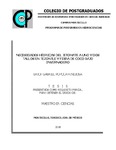| dc.description.abstract | Se evaluaron dos métodos para estimar las necesidades hídricas del jitomate utilizando un lisímetro de drenaje (2016) y la reflectometría de dominio de tiempo TDR (2017). Los experimentos se establecieron en el campus Montecillo del Colegio de Postgraduados, México, en condiciones de invernadero. Se utilizó un diseño experimental completamente al azar para el año 2016 y un diseño factorial completamente al azar para el 2017. Los sustratos utilizados fueron tezontle de granulometría gruesa para el primer año, y para el segundo, tezontle de granulometría media y fibra de coco. El sistema de riego fue por goteo para ambos experimentos, se programaron los riegos mediante un temporizador, además se determinaron las concentraciones iónicas para realizar la solución nutritiva. La variedad de jitomate fue Cid F1 el cual es de tipo saladette. Los tratamientos en estudio fueron T1: 1 Tallo y T2: 2 Tallos, y T1: Tezontle 2 Tallos, T2: Fibra 1 Tallo, T3: Tezontle 1 Tallo y T4: Fibra 2 Tallos, para los años 2016 y 2017, respectivamente. Las variables de respuesta fueron las necesidades hídricas del cultivo mediante el lisímetro y el TDR, rendimiento (kg/planta), eficiencia en el uso del agua (kg/m3), diámetro ecuatorial (mm), peso de fruto (g), numero de frutos por planta, calidad física del fruto clasificados mediante la norma mexicana NMX-FF-009 y con fines de exportación por la empresa PREMIER HORTICULTURA GROUP, S DE R.L DE C.V, además para el experimento del año 2017 se determinaron la calidad organoléptica: Firmeza (N) y solidos solubles (°Brix) y análisis de extracto celular de peciolo. Los resultados se analizaron mediante el programa estadístico SAS (Statistical Analysis System), con una significancia del 5%.
Las necesidades hídricas fueron de 135.97 y 162.39 L/planta para un ciclo de 149 días para los tratamientos correspondientes del año 2016. Para el 2017 se tuvieron 208.59, 95.82, 153.23 y 118.69 L/planta para los tratamientos correspondientes al año 2017, para un ciclo de 147 días. En el rendimiento no existen diferencias significativas, se obtuvieron 5.7 y 5.9 kg/planta para los tratamientos del 2016 mientras que para 2017 el rendimiento fue de 10.40, 5.19, 6.31 y 9 kg/planta para el T1, T2, T3 y T4, respectivamente. Para la clasificación de la fruta se utilizó el diámetro ecuatorial, mediante la norma mexicana la clasificación en su mayoría fue mediana y chica y para exportación fue grande y mediano (2016). Para el año 2017, la fruta se consideró mayormente en grande y mediana por la norma mexicana y para exportación se consideró extra grande y grande. No existe diferencia significativa en cuanto a la calidad organoléptica y los valores obtenidos del extracto celular de peciolo se consideran adecuados. _______________ HYDRAULIC NEEDS OF JITOMATE TO ONE AND TWO STEMS IN TEZONTLE AND FIBER OF COCO IN GREENHOUSE. ABSTRACT: Two methods were evaluated to estimate the tomato water needs using a drainage lysimeter (2016) and TDR time domain reflectometry (2017). The experiments were established in the Montecillo campus of the Colegio de Postgraduados, Mexico, under greenhouse conditions. A completely randomized experimental design was used for the year 2016 and a completely randomized factorial design for 2017. The substrates used were coarse-grained tezontle for the first year, and for the second, tezontle of medium granulometry and coconut fiber. The irrigation system was drip for both experiments, the risks were programmed by means of a timer, in addition the ionic concentrations were determined to make the nutritive solution. The variety of tomato was Cid F1 which is of the saladette type. The treatments under study were T1: 1 Stem and T2: 2 Stems, and T1: Tezontle 2 Stems, T2: Fiber 1 Stem, T3: Tezontle 1 Stem and T4: Fiber 2 Stems, for the years 2016 and 2017, respectively. The response variables were the water needs of the culture using lysimeter and TDR, yield (kg / plant), efficiency in water use (kg / m3), equatorial diameter (mm), fruit weight (g), number of fruits per plant, physical quality of the fruit classified by the Mexican standard NMX-FF-009 and for export purposes by the company PREMIER HORTICULTURA GROUP, S DE RL DE CV, also for the experiment of the year 2017 the organoleptic quality was determined: Firmness (N) and soluble solids (° Brix) and analysis of petiole cell extract. The results were analyzed by the statistical program SAS (Statistical Analysis System), with a significance of 5%. The water needs were of 135.97 and 162.39 L / plant for a cycle of 149 days for the corresponding treatments of the year 2016. For 2017 there were 208.59, 95.82, 153.23 and 118.69 L / plant for the treatments corresponding to the year 2017, for a 147 days cycle. In the yield there are no significant differences, 5.7 and 5.9 kg / plant were obtained for the treatments of 2016 while for 2017 the yield was 10.40, 5.19, 6.31 and 9 kg / plant for T1, T2, T3 and T4, respectively. For the classification of the fruit the equatorial diameter was used, by means of the Mexican norm the classification was mostly medium and small and for export it was large and medium (2016). For the year 2017, the fruit was considered mostly in large and medium by the Mexican norm and for export it was considered extra large and large. There is no significant difference in terms of organoleptic quality and the values obtained from the petiole cell extract are considered adequate. | es_MX |


